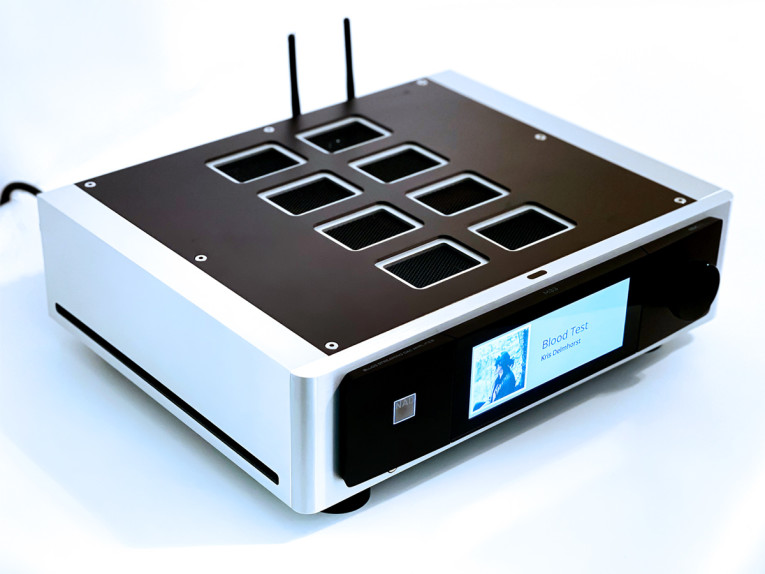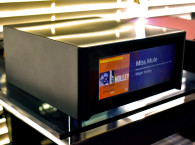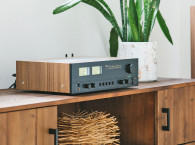Product Photos by Cynthia Wenslow
NAD is one of the longtime companies that has kept a consistent identity over the five decades of its existence and three successive owners — the brand has an honorable history of no-frills gear offering high performance and value to the broad middle price segment of the audio market.
Interestingly, NAD’s history actually traces back to the purchase of the storied loudspeaker company Acoustic Research (AR) by the large conglomerate Teledyne in the late 1960s. Teledyne was surprised that AR had been selling electronics as well as loudspeakers, and was only interested in the speakers. So New Acoustic Dimension, originally formed by its founder Dr. Martin Borish as a distribution company, purchased the designs, tooling, and supply chain that AR had been using, and brought in its principal electronics designer, Bjørn Erik Edvardsen.
Clearly, the concept of high performance at moderate price, AR’s claim to fame, was built into the company’s DNA. The NAD 3020 integrated amplifier, introduced in the late 1970s, sold millions of units and was the centerpiece of several of the sound systems I used back in those days. The secret to achieving this value vs. performance was a very forward-thinking business model, with local marketing and engineering and outsourced manufacturing. This is common practice today because of the vastly decreased capital expenditures and operating costs, but was a rarity 40 years ago, and a great challenge because getting reliable contract manufacturers was far more hit and miss than today.
After several ownership changes over the years, the contemporary NAD was acquired by Lenbrook, a family-owned Canadian company, which has accumulated a synergistic trio of audio companies: PSB loudspeakers, BlueSound audio software, and NAD. The combination of companies enables users to have a fully integrated Lenbrook system, with a rich feature set of control capabilities.
NAD’s flagship products are called the Masters Series, and the latest offering is its top-of-the-line M33. Recently, I had the chance to spend a few months using this remarkable product, the NAD Masters Series M33 BluOS Streaming DAC Amplifier.

The Product Concept
The M33 is designed as an actual all-in-one device, combining the functionality of a high-powered (200W into 8Ω, 380W into 4Ω) high-performance integrated amplifier having analog and digital I/O with a network streaming system to accommodate both modern and legacy sources. It also contains an electronic crossover for bi-amping. The superb room acoustics correction software, Dirac LE, is built in. Only speakers are required to complete a versatile audio system.
BlueSound’s proprietary operating system, BluOS, lies at the heart of the M33 system package. I described the features of this interface in my review of the NAD M10 (see Resources), but to summarize, it works through the home network, either via wired LAN or Wi-Fi, and allows control of multiple systems in a home from a single (or multiple, if desired) wireless control point. The BluOS app (available for Mac, PC, Android, and iOS) can be run from pads, phones, laptops, or even workstations.
It’s basically an audio “Swiss Army knife,” enabling the user to select the source (including streaming and music on network drives), select the room, select the hardware, and direct the music to whichever device and room is chosen. A nifty feature is “Follow Me,” the ability to move a playlist from one room and one device in the BlueOS ecosystem to the next as you move about the house, requiring only a tap on a virtual button.
Besides source and destination control, BluOS also enables control of basic audio functions. Although this can also be handled by dedicated remote controls (either the one provided with the M33 or programmable universal controls), many users, myself included, prefer using a smartphone for control since it’s handy, easy to use, and integrates the audio settings with music selection.
In my review of the M33’s smaller sibling (the M10, see Resources), I lamented that the term “lifestyle product” has developed a pejorative connotation. And in this case, an undeserved one — if you’re a serious music listener, having a single package with a high level of versatility and performance coupled with ease of use is a major positive. This may be less important to someone for whom music is a necessary evil for evaluating sound systems, but perfect for the music-first listener who doesn’t want to fool around with equipment but wants good sound. Besides working as a standalone app, BluOS integrates with home automation systems (e.g., Lutron, Crestron, Control 4, and several other popular systems).
Although it can be used as a conventional integrated amplifier, the M33 is fundamentally a network device. It can stream from Internet services (e.g., Amazon HD, Tidal, Qobuz, etc.) and from any NAS music libraries on the same network to which it’s connected. And because it’s a network device, just as with your computer, the M33 (and other BluOS devices) can get firmware updates automatically. NAD has been using this capability to fix bugs that weren’t caught during development but caused issues for some users. For example, in my M10 review, I noted that the digital inputs had periodic glitching, making measurement difficult and occasionally being severe enough to be audible.
A firmware update a few months ago fixed this issue without me having to do any work or having to send the unit to a service center. Keep in mind that many of the small issues I discovered during this review process may already have been fixed via the automatic updating.
Besides bug repair, the updates have also added new capabilities to the M33. The most recent rounds (as of the writing of this article) include the addition of Radio Paradise and Sirius XM to the streaming options. It is now also certified for Roon. For music played via a NAS drive, the M33 can handle just about all of the alphabet soup of formats: FLAC, AIFF, WAV, MQA, OGG, WMA, ALAC, OPUS, and probably a few more I missed. The M33 can also be controlled via voice commands using Alexa, Siri, and Google Assistant.
I mentioned Dirac room acoustics correction; the under-500Hz version is included. It may be upgraded to the full-range package for an additional $99. Many feel that the basic package is sufficient, but in my view, the small marginal cost for the full version is more than worth it. I have a much more detailed explanation of Dirac’s operation and details about setup in my review of the NAD M10. The basic version does support Dirac’s Bass Control for driving multiple woofers independently.
Finally, it should be mentioned that the power amplification here is a pair of Class-D modules using Eigentakt technology (see Resources) licensed from Purifi. My previous experience with Purifi Eigentakt confirmed that its amps had high power, ultra-low distortion and noise, low source impedance, and stability into every load I threw at it.
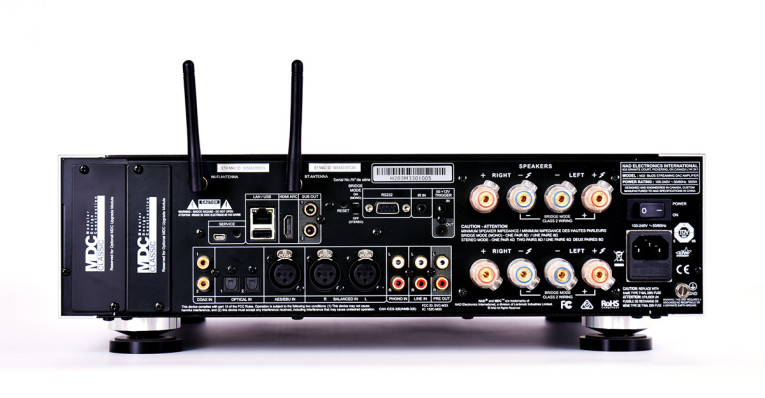
The M33 in Execution
The M33 is a moderately large but relatively light (22lb/10kg) unit with a front panel featuring a single large control knob and a black Gorilla glass LCD touch screen showing the user’s choice of input sources, album art, or a pair of large virtual power meters (Photo 1). The casework is an attractive and easy-to-maintain brushed metal, with vents on the top. The bottom has four hard metal cones as feet. If you’re worried about damaging furniture, four magnetic pucks with depressions in the center are provided to attach to the points of the cones.
The rear panel is where all the action is. Where the M33 fundamentally distinguishes itself from the M10 is greater input versatility (Photo 2). Besides the usual line level analog inputs, the M33 has balanced analog I/O, HDMI, two optical and two coaxial SPDIF inputs, balanced AES/EBU, and in a nod to fashionable anachronism, phono inputs. All analog inputs are digitized before being fed to the M33’s DSP and power amp sections.
There’s a dedicated headphone output, a feature lacking in the M10; Bluetooth headphone capability is still provided, however. The user can also send music to the M33 via Bluetooth; the M33 is equipped with aptX-HD. Similarly, Apple’s Airplay 2 can be used. There’s also two expansion slots, dubbed Modular Design Construction (MDC) to add in any future type of I/O that might become popular. The star of the show, suggested by the Wi-Fi antennas and the Ethernet connector, is certainly the network streaming capability.
A set of unbalanced preamp outputs are also provided so that an external power amp can be used, just in case the power of the M33 is insufficient. Unfortunately, it lacks the preamp to power amp jumpers that were useful for the old 3020 integrated so that the power amps can also be used in isolation (e.g., for driving a subwoofer while an external amp drives the main speakers). I hope that in a fit of nostalgia, NAD brings back that useful feature.
The M33 is packed in a manner that is functional but not over the top. Besides the main padded box and a slick cloth bag protecting the M33 from scuffing, there are two sub-boxes containing the power cords, Wi-Fi antennas, the remote control, a measurement mic and adapter for Dirac, and a USB thumb drive with manuals and other documentation (Photo 3). The remote control is remarkably solid and heavy, so much so that it could be a pretty effective weapon if thrown; no cheap plastic casing here! Adding to the impression of luxury, the USB drive is brushed metal and snapped into a leather scabbard with an embossed NAD logo.
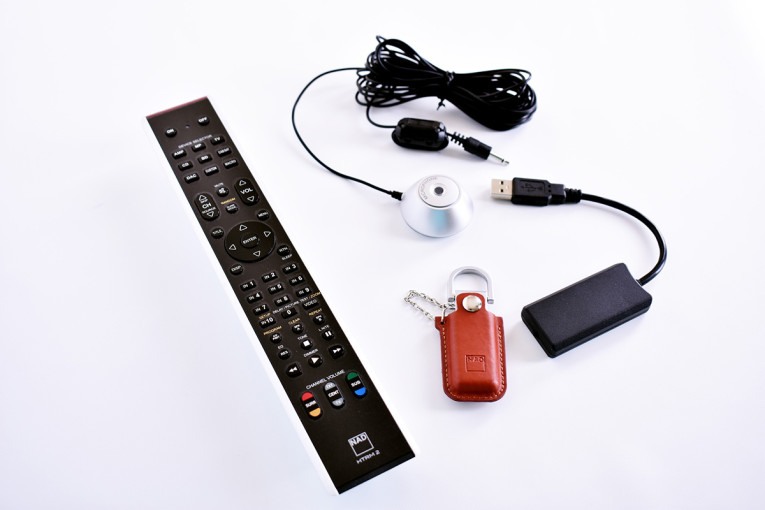
The moving magnet phono stage is bipolar op-amp based (NAD demurred on disclosure of the device used, but claims it is “known for its warm musical sound”). In moving magnet mode, it has 40dB of gain at 1kHz and a 47kΩ input impedance. In the context of the M33’s overall design, I was surprised to find that the RIAA is not done digitally after a flat gain block, but rather using a classic feedback EQ.
According to Chief Technical Officer Greg Stidsen, this results in more headroom before overload. NAD says that it uses close tolerance, premium parts (polystyrene caps, 1% resistors) for the EQ. One interesting design twist is the use of a parallel feedback loop that is frequency selective to implement the infrasonic filter, with a 10Hz inflection point and 24dB/octave slope. This provides protection against infrasonic noise (mechanical/acoustic feedback), which can drive the amplifier into clipping and speakers into excursion distortion at fairly low musical playback levels, but has much less impact on deep bass from music than, say, using the IEC amendment in the RIAA equalization.
When switched into moving coil mode, the input uses a discrete bipolar transistor flat gain stage with 20dB of gain and has a 100Ω input impedance.
The M33 in Use
The electrical setup of the M33 was simple, with balanced analog, unbalanced analog, and digital sources connected in seconds. The binding posts used for the speaker outputs are the same ones used across Lenbrook’s top-of-the-line products, and were easy and convenient to use for hooking up my speakers. They accommodate pretty hefty wires and spade lugs, as well as the usual banana and pin plugs, and are easily tightened by hand using a molded tab on the thumb nut for leverage. I really like that aspect of the ergonomics.
With all my positive anticipation at getting this beauty fired up and making music, the part I dreaded had to come first: setting it up on our wireless network. When I originally received the M10, getting it working via wireless was a major adventure, so much so that I recommended (and still recommend) purchasing from a dealer who agrees to set it up and get it running.
I was very pleasantly surprised to have the M33 setup go almost automatically. Once I had it added to the BluOS app on my phone, it immediately connected to our Wi-Fi and could stream via our music services or our network drive. Slick and smooth, until... When it comes to networking, nothing ever seems straightforward here. I always wonder if our setup should be used for worst-case testing. In any case, I moved the M10 to another room during the M33 testing with the idea of using the BluOS capability via Wi-Fi to control both. Unfortunately, adding the M33 caused the M10 to disappear from the network. This started me on a multi-week process with NAD’s technical support, and the final answer involved doing factory resets (considerably more work than a reboot) and setting the M10 up on an Ethernet connection before trying to connect it via Wi-Fi.
Once things were working, switching between players and rooms was very smooth and easy. That said, about once a week, the M33 would refuse to connect to the network. A relatively quick reboot would restore things, but still, this was a bit annoying. I will repeat my earlier advice: buy the M33 from a dealer willing to do setup and basic support.
I also felt that the sound seemed just a tiny bit forward and bright compared to the M10, but thought I’d check some measurements before trying to validate my impression with an ABX test. The first thing I checked was frequency response, and got a bit of a surprise (Figure 1); the top three octaves were boosted by about 0.5dB. I checked the tone controls in BlueOS and the button was set to off. Turning it on, the treble slider was up a notch or two, which I thought shouldn’t matter if the tone controls are supposedly off. But just for fun, I set the treble control for flat before turning the tone controls off again. Lo and behold, the frequency response was now flat. A minor bug, but be careful that you don’t repeat my mistake.
Since I already had a license for the full-frequency version of Dirac, I was able to get that up and running on the M33 in seconds. Unfortunately, it would not allow me to use the project files from my previous measurements, so the Dirac measurements had to be repeated. I’ve done them enough times and had left in place the floor and mic stand markings that I used for the M10 review so I was through the measurements in minutes. A very minor inconvenience.
Once everything was set up and Dirac was in play, all the minor annoyances faded away—the sound was absolutely gorgeous. I expected the M33 to sound pretty much like the M10, and that was indeed the case, as far as it went. By that last phrase, I mean that on particularly challenging material, I could squeeze a bit more volume out of the M33 because of the higher available power from the Eigentakt modules.
For example, I have recently been bingeing on Dream Theater, and at the appropriate volume using the M10, I start hearing a bit of graininess set in from time to time; I was particularly getting this impression when listening to “The Dance of Eternity” from their superb Metropolis Part 2: Scenes from a Memory album (Elektra), streamed via Amazon HD. At subjectively similar levels, the M33 sounded seamless and completely in control.
On the more delicate end, Sarah Jarosz’s “Maggie” from World On The Ground (Rounder) really showed off Dirac’s ability to separate instruments in a mix. The downside is that it’s too easy to hear the clumsy reverb on Jarosz’s voice, but still, the overall purity of the mix is honored. This led me to Nickel Creek’s “Elsie” from A Dotted Line (Nonesuch) with a beautifully recorded violin and mandolin lines dancing with the flat-picked guitar. And then... well, let me just say that streaming from a service like Amazon HD has destroyed hundreds of hours of productive time for me as I run down one musical rabbit hole after another and listen to music instead of being productive. Ah, well, life in 2021.
Just for completeness, I double-checked that the MQA decoding functioned from Tidal. Well, the light went on, so I trust that there was actually decoding. And as non-auditory subjective comment, the LCD touch display was sharp and clear, and very responsive to touch. The large volume control had a smooth feel and was a tactile pleasure to use. The look and feel here are absolutely impeccable. Through my time with it, the M33 was quiet, powerful, clean, and responsive—an absolute pleasure to use every day.
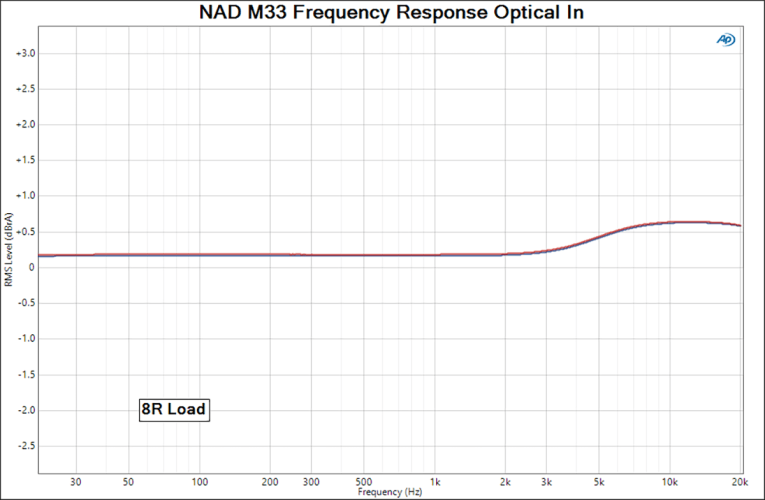
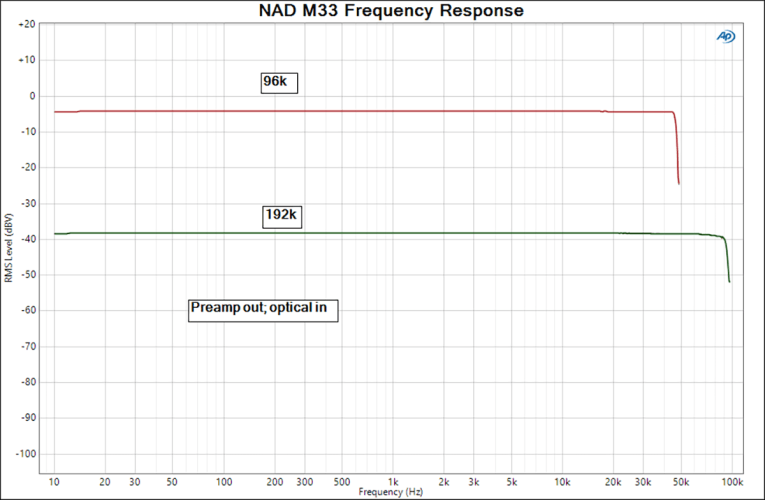
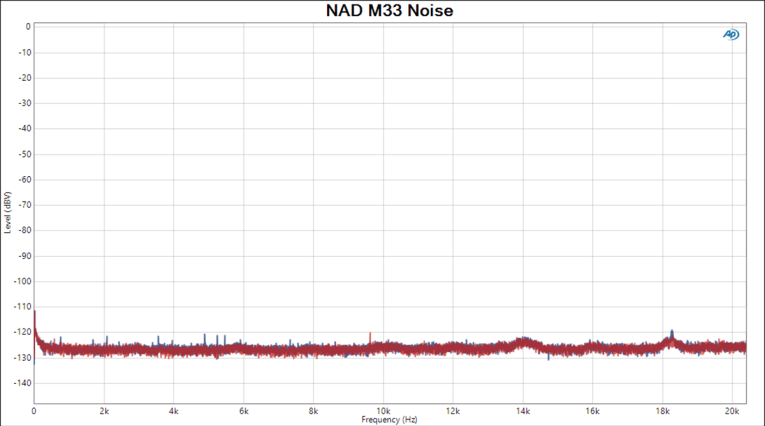
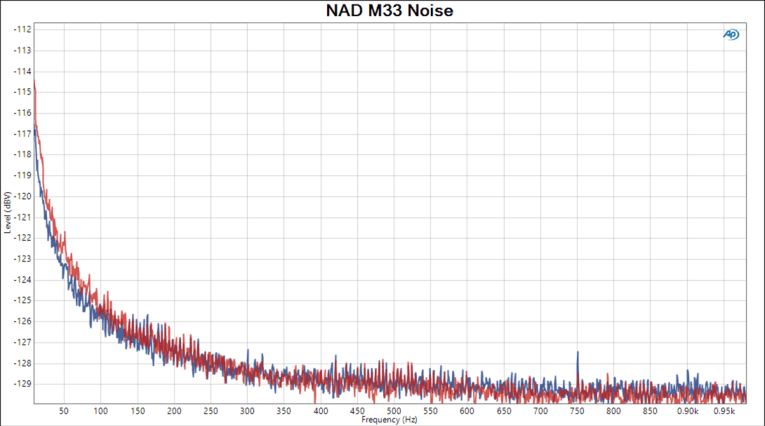
The M33 on the Bench
It’s always nice to have an engineered (as opposed to “designed”) product on the test bench. And indeed, the M33 showed very few surprises. Because the M33s were in somewhat short supply during this review, my time with it was somewhat limited. So the measurements here focused on some basic stuff that I haven’t seen elsewhere and a few things that might present an issue for users. As usual, my test setup comprises an Audio Precision APx525 audio analyzer and various homemade dummy loads for the power amplifier.
Figure 2 shows the frequency response measured at the preamp outputs at two different sampling rates. There’s almost no droop until the Nyquist cut-off. The source impedance of the amplifier was about 0.2Ω, so the frequency response will not be strongly affected by the varying impedance of loudspeaker loads. Like its smaller sibling, the M33 was dead silent in my listening setup. Figure 3 shows why — there’s no appreciable noise spikes or hash. At lower frequencies, the noise rises slightly, as shown in Figure 4, with a noise corner frequency of roughly 100Hz to 150Hz.
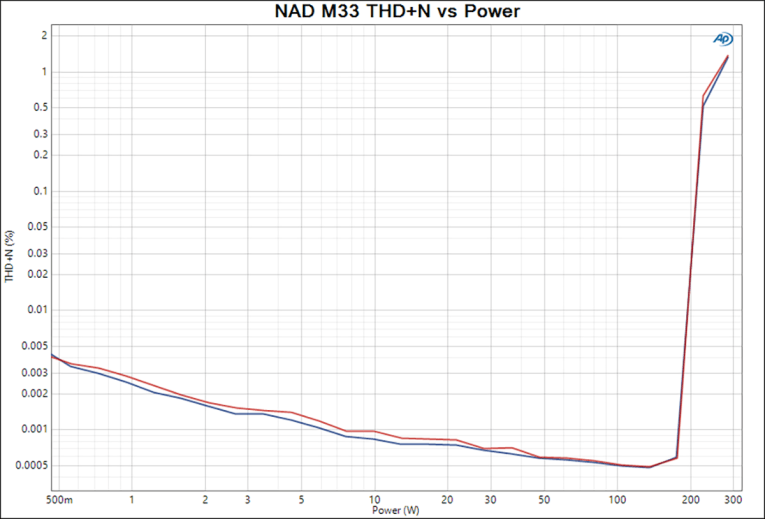
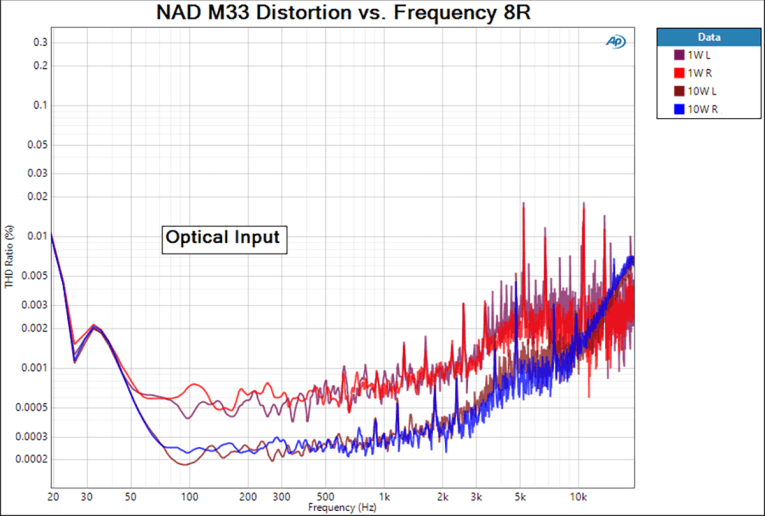
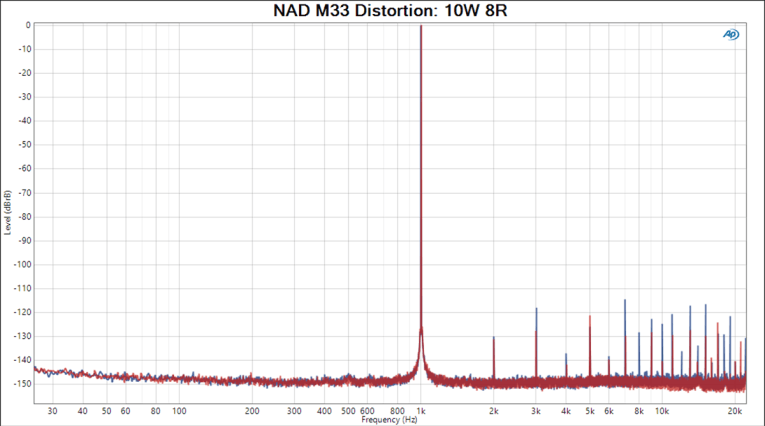

The Eigentakt technology power amps do not disappoint. Figure 5 shows THD+N as a function of power for a 1kHz signal driving an 8Ω load. Power exceeds 260W at the 1% distortion point, easily beating specification. Figure 6 shows the variation of distortion plus noise with frequency at power levels of 1W and 10W into 8Ω; it appears to be dominated by noise rather than harmonics. This is confirmed by looking at the distortion spectrum (Figure 7), which shows harmonic components barely larger than (and perhaps even below) the AP analyzer’s residual distortion.
Increasing the power to 150W yielded the spectrum in Figure 8. Again, the distortion components are dominated by the AP analyzer’s residuals. This is consistent with my previous measurements of Eigentakt amplification. These are remarkable works of engineering!
In much modern equipment, phono stages are added in as afterthoughts — and the performance proves it. Is that the case here as well? Figure 9 shows the frequency response of the phono stage when driven by an inverse-RIAA equalized signal. There’s a slight lift in the top two octaves (0.2dB or so), which is negligible. Otherwise, the response is quite flat, and even more impressively, the channel-to-channel matching is nearly perfect.
Likewise, the distortion of the phono stage at 500mV preamp output (Figure 10) is very low, rising a bit in the lowest frequencies where the gain is highest. This phono stage is definitely not an afterthought and shows excellent engineering and execution.
Finally, the M33 has an adjustable frequency electronic crossover for use in systems having separate woofers or subwoofers. NAD does not specify filter responses, or if it does, it’s deeply buried in its literature. Figure 11 shows the response at subwoofer and main outputs with the crossover set at 110Hz. These conform closely to a fourth-order Linkwitz-Reilly response. As was the case for the M10, the bass output is inexplicably 6dB lower than the main output, and the relative levels cannot be adjusted. So having a separate gain control for the subwoofers is a must. The stereo bass outputs are independent of each other, which is a big advantage at higher crossover frequencies.

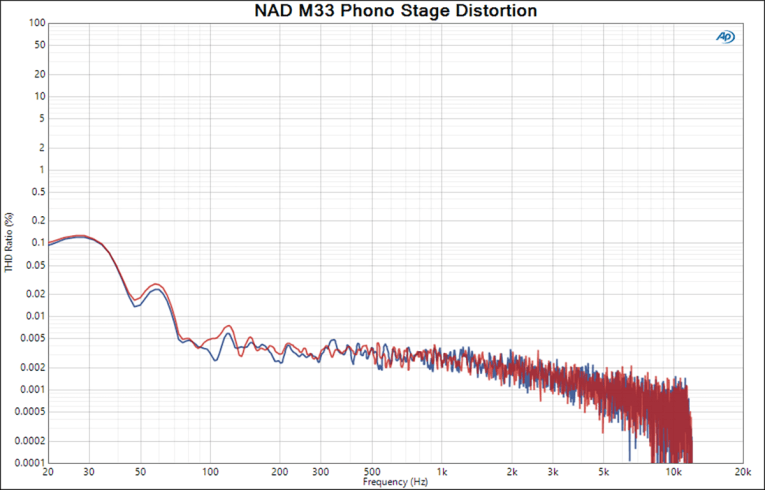
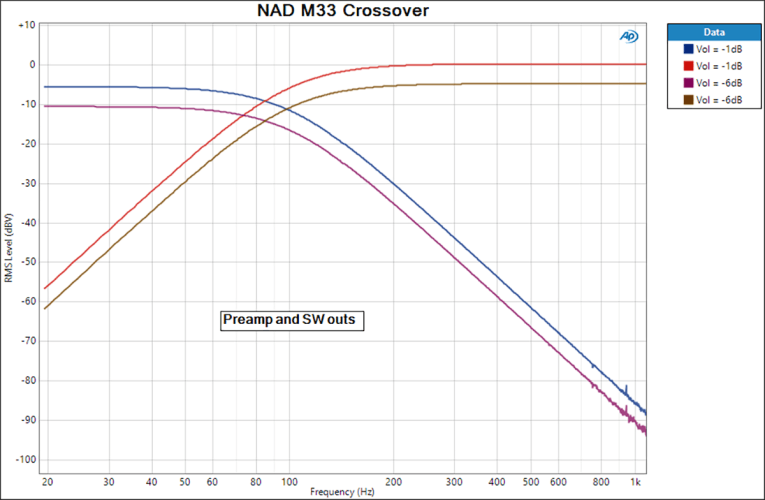
Conclusions
The M33 is not inexpensive at about $5000, but the performance and feature set packed into it are quite significant! The user gets a single box that handles just about any conceivably input type, with full network and streaming capability, the muscle needed to drive nearly any speaker load; one of the top room acoustics corrections systems; the ability to play files in almost every imaginable format (including MQA); and integration into home automation systems. There’s also the capability of expansion for future formats. Additionally, the user interface app is slick and intuitive, has multi-device capability, and receives regular updates, bug fixes, and new features for both the BluOS app and the M33 via the Internet.
There’s still a few bugs to be squashed, but they’re relatively minor and easy to work around; they could even be fixed by the time this review is in print. But overall, the M33 is the complete package — it does it all, the sort of product that ends the chase for better sound on the source and electronics end. It’s had a lot of accolades and based on my experience with it in my listening room, I think it absolutely deserves them. If your main love is playing with equipment and swapping, it may take the fun out of the hobby. If your main love is music and sound, this is pretty much as good as it gets.
Great product, highly recommended. aX
Author Acknowledgements: I’d like to thank Jeff Touzeau of Hummingbird Media for arranging the review and diligently connecting me with the right people to answer my questions. Lenbrook’s Chief Technology Officer, Greg Stidsen, was a fountain of useful information and historical trivia. And Bob Moran, NAD’s stalwart tech support manager, patiently helped me through my various networking issues.
Resources
NAD M33 Product Webpage | https://nadelectronics.com/product/m33-bluos-streaming-dac-amplifier
S. Yaniger, “NAD M10 Masters Series Streaming Amplifier,” audioXpress, August 2020,
S. Yaniger, “A Tale of Two Class D Amplifiers,” audioXpress, July 2020,
 About the Author
About the AuthorStuart Yaniger has been designing and building audio equipment for nearly half a century, and currently works as the R&D director for a construction products company. His professional research interests have spanned theoretical physics, electronics, chemistry, spectroscopy, aerospace, biology, and sensory science. One day, he will figure out what he would like to be when he grows up.
This article was published in audioXpress, July 2021
